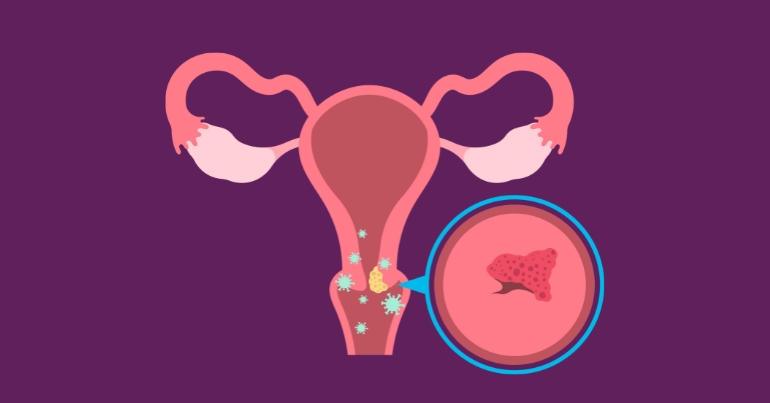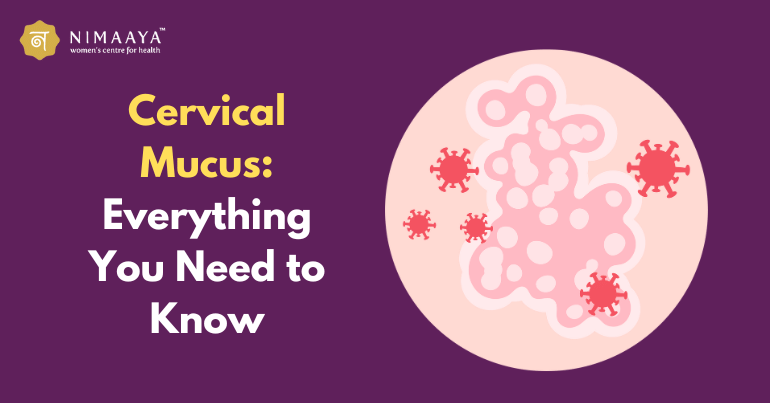Cervical mucus is a crucial player in female reproductive well-being and fertility. This mucus, produced in the cervix, undergoes several changes during the menstrual cycle concerning consistency, texture, and volume. It helps women know their bodies’ fertility status hence acting as an earthly symbol that indicates if someone is fertile or not. For those who are trying either to conceive or to prevent pregnancy without using artificial contraceptives, monitoring cervical fluid is very useful; hence it becomes part of fertility awareness methods.
This article will explore the cervical mucus definition, its types, how it changes throughout the menstrual cycle, and how it relates to getting pregnant (fertility). We would also go ahead to show tracking methods for cervical mucus, identifying abnormal fluids and describing its importance in infertility treatments such as IUI and IVF.
What is Cervical Mucus?

Cervical mucus is a fluid secreted by the glands within the cervix. It plays an essential role in reproductive health by creating an environment that helps sperm survive and travel through the cervix to reach the uterus. The amount and consistency of cervical mucus are regulated by varying hormones, mainly, estrogen and progesterone, all through a woman’s menstrual cycle.
In the first half of the menstrual cycle, estrogen levels rise leading to increased production of cervical mucus. The mucus becomes more slippery and stretchy as ovulation nears enhancing ease of movement for sperm. After ovulation, progesterone dominates leading to the thickening of cervical mucus which acts as a block against sperm and protects the uterus from infections.
Therefore, understanding how it works will help us gain insights into one’s health status or fertility.
The Different Types of Cervical Mucus Throughout the Menstrual Cycle
During the menstrual cycle, distinct changes in cervical mucus take place since the body is preparing for pregnancy. Here are four types of cervical mucus and their importance:
‣ Dry or Absence of Mucus (Post-Menstruation):
After menstruation, many women experience little to no cervical mucus. During this stage, the vaginal environment feels dry and chances of conception are low because there is no fertile mucus.
‣ Sticky or Creamy Mucus (Early Cycle, Pre-Ovulation):
As estrogen levels start increasing; the cervix produces more mucus but it’s thick, sticky, or creamy-like. It is not suitable for sperm at all and it is rare to be fertile here.
‣ Egg White Mucus (Ovulation Period):
The most fertile cervical mucus looks like raw egg whites: clear, stretchy, and slippery. This type of mucus creates an ideal environment for sperm survival and mobility. It increases the chances of conceiving by promoting sperm movement through the cervical canal into the uterine cavity.
‣ Watery or Thin Mucus (After Ovulation):
After ovulation, the body shifts into a luteal phase where there is less fertile mucus and conception is unlikely. Progesterone takes over, preparing the body for possible pregnancy by thickening the mucus into a barrier against outside interference.
How to Track Cervical Mucus for Fertility Awareness
Monitoring cervical mucus is among the simple yet efficient approaches to observing ovulation. The following guide will take women on a step-by-step process of tracking mucus and understanding their fertile windows better:
‣ Daily Observation:
Observe cervical mucus every day at the same time to see changes in consistency, color, and amount. This can be done by putting toilet paper on before urinating, taking clean fingers to collect mucus at the vaginal opening, or observing what is left on panties.
‣ Pattern Recognition:
Over time, some patterns will come out clearly. In the most fertile phase, for instance, it may be likened to egg whites while at times of less fertility, it may be dry or sticky. Particularly for someone whose dreams always include getting pregnant, one must always note that uniformity is very important while keeping such tabs.
‣ Document Observations:
Keep a journal of daily variations of cervical mucus. Many apps assist in keeping track of fertility, where not only mucus data but also basal body temperature can be recorded. Therefore, this combined information gives a more precise indication of ovulation.
‣ Know Your Cycle:
To time the changes in mucus correctly, you need to understand your cycle. Generally, fertile mucus shows up about five days before ovulation and remains until just after it. Whenever trying for a baby, couples should go for sex within this period.
By regularly observing and tracking cervical mucus, women can naturally predict their most fertile days, making it a useful tool for either family planning or understanding their menstrual health.
Cervical Mucus and Ovulation
The release of a mature egg from the ovary is known as ovulation, which is characterized as the most fertile period in a woman’s cycle. Cervical mucus plays an integral role during ovulation by helping sperm reach the egg for fertilization.
Just before ovulation, cervical mucus changes significantly, becoming clearer, more abundant, and slippery. This egg white-like mucus provides an ideal environment for sperm, allowing it to move freely through the cervix and into the uterus. The mucus’s alkaline nature also helps neutralize the acidic environment of the vagina, enhancing sperm survival.
After ovulation, mucus changes again, becoming thicker and less abundant. This shift helps to block sperm from entering the uterus, as the body is no longer in its fertile phase.
For women trying to conceive, understanding when this fertile mucus appears is crucial. Intercourse during the few days of egg white cervical mucus dramatically increases the likelihood of conception. By observing these changes, women can better time their efforts to maximize fertility.
Abnormal Cervical Mucus: What to Look For
Abnormalities may sometimes indicate a health problem, even though it usually changes during the menstrual cycle. Here are some of the signs:
‣ Bad smell:
A strong unpleasant smell in cervical fluid might indicate an infection like bacterial vaginosis.
‣ Unusual color:
Healthy cervical mucus is typically clear or milky white. Yellow, green, or grey-colored secretions can indicate infections or sexually transmitted infections.
‣ Thick or clumpy texture:
While cervical mucus after ovulation is thicker, always having thick clumps like cottage cheese may mean that there is a yeast infection present.
‣ Too much mucus:
This could result from hormonal imbalances or certain medications such as contraceptives when one experiences a sudden unexplained increase in cervical fluid production.
It is essential to see a doctor for diagnosis and treatment if you notice any of these symptoms. This is because ignoring abnormal cervical fluid can lead to more complicated reproductive health issues in the future.
Cervical Mucus and Fertility Treatments
It is important in conception among women who are going through fertility treatments. Intrauterine Insemination (IUI) and In Vitro Fertilization (IVF) are examples of these treatments that usually consider cervical mucus for a greater chance of success.
‣ Intrauterine Insemination (IUI):
This method involves injecting sperm directly into the uterus, skipping the cervix. But for a natural conception to take place, the cervical mucous must be healthy enough to guide sperm to the egg. That is; if it is too thick and/or acid, it can act as a barrier for sperms reaching there, so when IUI happens, it bypasses such barriers.
‣ In Vitro Fertilization (IVF):
Since fertilization happens outside the body during IVF, cervical is not that relevant. But then again, such abnormalities in cervical mucus still reflect some hormonal imbalance or any other fertility problem that might be affecting the whole process. Therefore, in such cases, doctors personalize their treatment according to what caused them by providing medications meant to enhance the quality of mucus.
Lifestyle Factors Affecting
Cervical mucus production and quality can be affected by various lifestyle factors. A healthy lifestyle helps the reproductive system function properly, leading to healthy cervical mucus production. Some of the key factors include:
‣ Hydration:
Staying well-hydrated is crucial for cervical mucus production. Dehydration may cause reduced levels of this fluid, making it harder for sperm to pass through the cervix.
‣ Diet:
A balanced diet that contains plenty of vitamins, antioxidants, and omega-3 fatty acids promotes healthy cervical fluid. Including dark leafy greens, nuts and oily fish in your meals is a good idea.
‣ Stress:
Chronic stress affects hormone levels which in turn lead to irregular menstruation cycles in addition to affecting the quality and consistency of cervical mucus. Restoring balance is possible when stress management techniques like yoga and meditation are practiced.
‣ Medications:
Some medications such as antihistamines and hormonal contraception may influence mucus production. For instance, antihistamines dry up fluid membranes thereby reducing cervical fluid while birth control pills suppress ovulation thus altering natural mucus formation.
Positive lifestyle changes can result in improved reproductive health; optimal cervical fluid for fertility is also guaranteed as a result of making such changes.
Conclusion
The adaptability of cervical mucus to convey fertility states among women is worth noting. Changes in the menstrual cycle may offer vital information for women wishing to conceive or assess their ovulation period. Therefore, during this time, a woman will be able to tell when it is right for her to conceive by simply relying on her organic signs.
Nonetheless, altered mucus also points out potential problems with one’s health such as infections or hormonal dysfunctions leading to abnormal function. To such an extent, one should seek medical assistance.
Fertility clinics such as the Nimaaya IVF Center specialize in diagnosing and treating fertility disorders including those that are motility-related (abnormal cervical mucous). Facilitating such couples parenting therapy has become Nimaaya IVF Hospital where advanced technologies go hand in glove with a patient-centred framework on reproductive health challenges that couples face. Our specialists Dr. Pooja Nadkarni and Dr. Yuvrajsingh Jadeja’s guide on cervical mucus just like other fertility treatments will always be provided by their experienced team who gives personalized care considering everything from compassion to the attention devoted towards every needy client.


